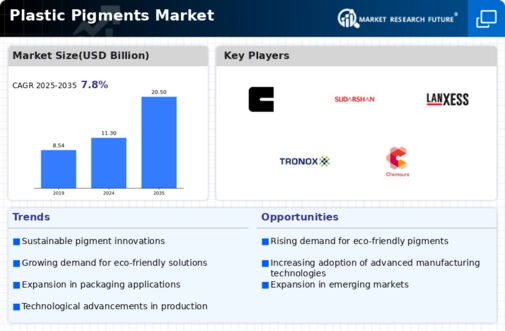-
Executive Summary
-
Scope of the Report
-
2.1
-
Market Definition
-
Scope of the Study
- Research Objectives
- Assumptions & Limitations
-
Market Structure
-
Market
-
Research Methodology
-
Research Process
-
Secondary Research
-
Primary Research
-
Forecast Model
-
Market Landscape
-
4.1
-
Five Forces Analysis
-
of Buyers
-
Pigments Market
-
Threat of New Entrants
-
Bargaining power
-
Bargaining power of Suppliers
-
Threat of Substitutes
-
Segment Rivalry
-
Value Chain/Supply Chain of Global Plastic
-
Industry Overview of Global Plastic Pigments Market
-
5.1
-
Introduction
-
Growth Drivers
-
Impact Analysis
-
Market
-
Challenges
-
Market Trends
-
Introduction
-
Growth Trends
-
Impact Analysis
-
Global Plastic Pigments Market, by Type
-
7.1
-
Introduction
-
Inorganic Pigments
- Market Estimates & Forecast,
- Market Estimates & Forecast, by Region, 2020−2027
- Titanium Dioxide
- Iron Oxide
-
7.2.5
-
Carbon Black
-
7.2.6
-
Chromium Compounds
-
7.2.7
-
Others
-
Global
-
Plastic Pigments Market, by Application
-
Introduction
-
Packaging
- Market Estimates & Forecast, 2020–2027
- Market Estimates
-
& Forecast, by Region, 2020–2027
-
Automotive
- Market
- Market Estimates & Forecast,
-
Estimates & Forecast, 2020–2027
-
by Region, 2020–2027
-
Building & Construction
- Market
- Market Estimates & Forecast,
-
Estimates & Forecast, 2020–2027
-
by Region, 2020–2027
-
Healthcare
- Market Estimates &
- Market Estimates & Forecast, by Region,
-
Forecast, 2020–2027
-
Consumer Goods
- Market Estimates & Forecast,
- Market Estimates & Forecast, by Region, 2020–2027
-
Others
- Market Estimates & Forecast, 2020–2027
-
8.6.2
-
Market Estimates & Forecast, by Region, 2020–2027
-
Global Plastic
-
Pigments Market, by Region
-
Introduction
-
North America
- Market Estimates &
- Market Estimates & Forecast, by
- US
-
9.2.1
-
Market Estimates & Forecast, 2020–2027
-
Forecast, by Type, 2020–2027
-
Application, 2020–2027
-
9.2.5
-
Canada
-
9.2.5.2
-
Market Estimates & Forecast, by Type, 2020–2027
-
& Forecast, by Application, 2020–2027
-
Estimates & Forecast, 2020–2027
-
by Type, 2020–2027
-
9.3.5.
-
France
-
9.3.5.2
-
Market Estimates
-
Europe
- Market
- Market Estimates & Forecast,
- Market Estimates & Forecast, by Application,
- Germany
-
Market Estimates & Forecast, by Type, 2020–2027
-
& Forecast, by Application, 2020–2027
-
Estimates & Forecast, 2020–2027
-
by Type, 2020–2027
-
9.3.7.3
-
Market Estimates
-
Italy
-
Market
-
Market Estimates & Forecast,
-
Market Estimates & Forecast, by Application,
-
Spain
-
Market Estimates & Forecast, 2020–2027
-
Market Estimates & Forecast, by Type, 2020–2027
-
Market Estimates & Forecast, by Application, 2020–2027
-
& Forecast, by Type, 2020–2027
-
by Application, 2020–2027
-
& Forecast, 2020–2027
-
Type, 2020–2027
-
9.4
-
Asia-Pacific
-
9.4.2
-
UK
-
Market Estimates & Forecast, 2020–2027
-
Market Estimates
-
Market Estimates & Forecast,
-
Russia
-
Market Estimates
-
Market Estimates & Forecast, by
-
Market Estimates & Forecast, by Application,
-
Poland
-
Market Estimates & Forecast,
-
Market Estimates & Forecast, by Type, 2020–2027
-
Market Estimates & Forecast, by Application, 2020–2027
-
Market Estimates & Forecast, 2020–2027
-
Market Estimates & Forecast, by Type, 2020–2027
-
& Forecast, by Application, 2020–2027
-
Estimates & Forecast, 2020–2027
-
by Type, 2020–2027
-
9.4.4.3
-
Market Estimates
-
China
-
Market
-
Market Estimates & Forecast,
-
Market Estimates & Forecast, by Application,
-
India
-
Market Estimates & Forecast, 2020–2027
-
Market Estimates & Forecast, by Type, 2020–2027
-
Market Estimates & Forecast, by Application, 2020–2027
-
& Forecast, by Type, 2020–2027
-
by Application, 2020–2027
-
& Forecast, 2020–2027
-
Type, 2020–2027
-
9.4.9
-
Rest of Asia-Pacific
-
9.4.9.3
-
Japan
-
Market Estimates & Forecast, 2020–2027
-
Market Estimates
-
Market Estimates & Forecast,
-
Australia
-
Market Estimates
-
Market Estimates & Forecast, by
-
Market Estimates & Forecast, by Application,
-
New Zealand
-
Market Estimates & Forecast,
-
Market Estimates & Forecast, by Type, 2020–2027
-
Market Estimates & Forecast, by Application, 2020–2027
-
Market Estimates & Forecast, 2020–2027
-
Market Estimates & Forecast, by Type, 2020–2027
-
Market Estimates & Forecast, by Application, 2020–2027
-
Middle
- Market Estimates & Forecast, 2020–2027
- Market Estimates & Forecast, by Type, 2020–2027
- Market
- Turkey
- Israel
- North Africa
- Rest of the Middle East
-
East & Africa
-
Estimates & Forecast, by Application, 2020–2027
-
9.5.4.1
-
Market Estimates & Forecast, 2020–2027
-
Forecast, by Type, 2020–2027
-
by Application, 2020–2027
-
& Forecast, 2020–2027
-
Type, 2020–2027
-
9.5.7
-
GCC
-
Estimates & Forecast, by Type, 2020–2027
-
& Forecast, by Application, 2020–2027
-
& Africa
-
9.5.8.2
-
Market Estimates & Forecast, by Type, 2020–2027
-
& Forecast, by Application, 2020–2027
-
9.6.1
-
Market Estimates & Forecast, 2020–2027
-
Forecast, by Type, 2020–2027
-
Application, 2020–2027
-
Forecast, 2020–2027
-
9.6.5.3
-
Market Estimates
-
Latin America
- Market Estimates &
- Market Estimates & Forecast, by
- Brazil
- Argentina
-
Market Estimates & Forecast, by Application, 2020–2027
-
Estimates & Forecast, by Type, 2020–2027
-
& Forecast, by Application, 2020–2027
-
Estimates & Forecast, by Type, 2020–2027
-
& Forecast, by Application, 2020–2027
-
Mexico
-
Market Estimates & Forecast, 2020–2027
-
Market
-
Market Estimates
-
Rest of Latin America
-
Market Estimates & Forecast, 2020–2027
-
Market
-
Market Estimates
-
Company Landscape
-
11.
-
Company Profiles
-
BASF SE
- Company Overview
- Type/Business
- Financial Updates
- Key Developments
- Company Overview
- Type/Business Segment Overview
- Financial Updates
- Key Developments
-
Segment Overview
-
11.2
-
Heubach GmbH
-
Clariant
- Type/Business Segment Overview
- Financial
- Key Developments
-
11.3.1
-
Company Overview
-
Updates
-
Sudarshan Chemical Industries Limited
- Company Overview
- Type/Business Segment Overview
- Key Developments
-
11.4.3
-
Financial Updates
-
DIC CORPORATION
- Type/Business Segment Overview
- Financial
- Key Developments
-
11.5.1
-
Company Overview
-
Updates
-
Atul Ltd
- Company Overview
- Type/Business Segment Overview
- Financial Updates
-
11.6.4
-
Key Developments
-
Lanxess
- Company Overview
- Type/Business
- Financial Updates
- Key Developments
- Company Overview
- Type/Business Segment
- Financial Updates
- Key Developments
-
Segment Overview
-
11.8
-
Mazda Colours Ltd.
-
Overview
-
Tronox
- Company Overview
- Type/Business Segment Overview
- Financial Updates
- Key Developments
-
Limited
-
The Chemours
- Company Overview
- Type/Business Segment Overview
- Financial Updates
- Key Developments
-
Company.
-
Conclusion
-
LIST OF TABLES
-
World Population in Major Regions (2020–2030)
-
Global Plastic Pigments Market, by Region, 2020–2027
-
Table
-
North America: Plastic Pigments Market, by Country, 2020–2027
-
Table
-
Europe: Plastic Pigments Market, by Country, 2020–2027
-
Asia-Pacific:
-
Plastic Pigments Market, by Country, 2020–2027
-
Middle East &
-
Africa: Plastic Pigments Market, by Country, 2020–2027
-
Latin
-
America: Plastic Pigments Market, by Country, 2020–2027
-
Global
-
Plastic Pigments Type Market, by Region, 2020–2027
-
North America:
-
Plastic Pigments Type Market, by Country, 2020–2027
-
Europe:
-
Plastic Pigments Type Market, by Country, 2020–2027
-
Table11 Asia-Pacific:
-
Plastic Pigments Type Market, by Country, 2020–2027
-
Table13 Middle East
-
& Africa: Plastic Pigments Type Market, by Country, 2020–2027
-
Table12
-
Latin America: Plastic Pigments Type Market, by Country, 2020–2027
-
Table14
-
North America: Plastic Pigments Application Market, by Country, 2020–2027
-
Table13 Europe: Plastic Pigments Application Market, by Country, 2020–2027
-
Table14 Asia-Pacific: Plastic Pigments Application Market, by Country, 2020–2027
-
Table16 Middle East & Africa: Plastic Pigments Application Market, by Country,
-
Table15 Latin America: Plastic Pigments Application Market,
-
by Country, 2020–2027
-
Table23 Global Type Market, by Region, 2020–2027
-
Table24 Global Application Market, by Region, 2020–2027
-
Table25 North
-
America: Plastic Pigments Market, by Country, 2020–2027
-
Table26 North
-
America: Plastic Pigments Market, by Type, 2020–2027
-
Table27 North America:
-
Plastic Pigments Market, by Application, 2020–2027
-
Table28 Europe: Plastic
-
Pigments Market, by Country, 2020–2027
-
Table29 Europe: Plastic Pigments
-
Market, by Type, 2020–2027
-
Table30 Europe: Plastic Pigments Market,
-
by Application, 2020–2027
-
Table31 Asia-Pacific: Plastic Pigments Market,
-
by Country, 2020–2027
-
Table32 Asia-Pacific: Plastic Pigments Market,
-
by Type, 2020–2027
-
Table33 Asia-Pacific: Plastic Pigments Market, by
-
Application, 2020–2027
-
Table36 Middle East & Africa: Plastic Pigments
-
Market, by Country, 2020–2027
-
Table37 Middle East & Africa Plastic
-
Pigments Market, by Type, 2020–2027
-
Table33 Middle East & Africa:
-
Plastic Pigments Market, by Application, 2020–2027
-
Table34 Latin America:
-
Plastic Pigments Market, by Country, 2020–2027
-
Table35 Latin America
-
Plastic Pigments Market, by Type, 2020–2027
-
Table33 Latin America: Plastic
-
Pigments Market, by Application, 2020–2027
-
LIST OF FIGURES
-
Global Plastic Pigments Market Segmentation
-
Forecast Methodology
-
Five Forces Analysis of Global Plastic Pigments Market
-
FIGURE 4
-
Value Chain of Global Plastic Pigments Market
-
Share of Global Plastic
-
Pigments Market in 2020, by Country (%)
-
Global Plastic Pigments Market,
-
Sub-Segments of Type, 2020
-
Global Plastic
-
Pigments Market Size, by Type, 2020
-
Share of Global Plastic Pigments
-
Market, by Type, 2020–2027
-
Sub-Segments of Application
-
FIGURE
-
Global Plastic Pigments Market Size, by Application, 2020
-
Share
-
of Global Plastic Pigments Market, by Application, 2020–2027









Leave a Comment